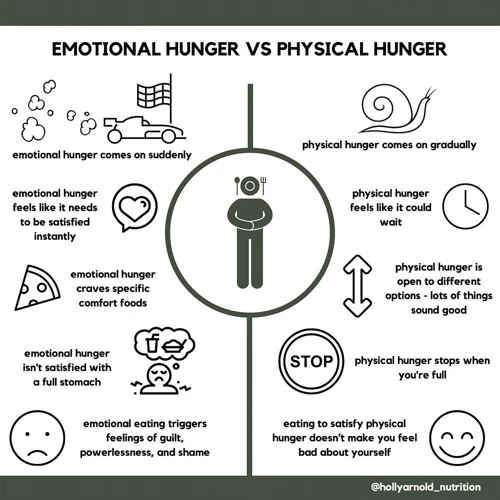Have you ever found yourself reaching for food when you’re not even hungry? Maybe you’ve had a long day at work or a stressful argument with a loved one, and suddenly, you’re drawn to the comfort of your favorite snack. It’s easy to mistake emotional hunger for physical hunger, but they are two very different things. Understanding the difference between the two can help you make healthier choices and improve your relationship with food. In this article, we’ll explore how to distinguish physical hunger from emotional hunger and provide coping strategies for managing emotional hunger and cravings. Let’s dive in.
What is Physical Hunger?
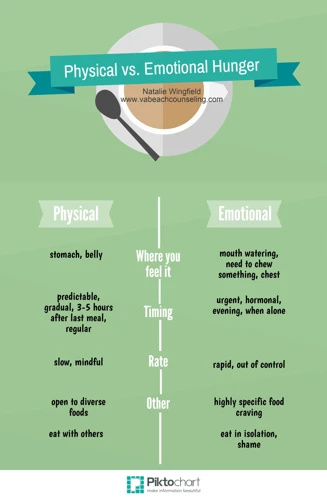
Many of us have experienced the feeling of physical hunger, but what exactly is it? Physical hunger can be defined as the physiological need for food, driven by the body’s need for nutrients and energy to function properly. It is a biological response that occurs when the body’s blood sugar levels drop, indicating a need for more energy. This type of hunger is important to recognize and address, as ignoring it can lead to negative consequences for both our physical and mental health. For example, it can result in irritability, fatigue, and difficulty concentrating. To learn more about physical hunger and its signs, continue reading below.
Signs of Physical Hunger
There are several signs that indicate physical hunger. One key sign is a gradual onset of hunger pangs, which can be felt in the stomach. These hunger pangs may start off as mild discomfort and gradually increase in intensity if not satisfied with food. Additionally, physical hunger can cause a growling or rumbling sensation in the stomach, which is a result of the digestive muscles contracting as they search for food to process.
Other signs of physical hunger may include weakness or lightheadedness, which occurs when the body has not received the necessary energy and nutrients from food. Difficulty concentrating and irritability are also common signs of physical hunger, as the brain requires glucose to function optimally.
However, it is important to note that physical hunger is generally satisfied by a variety of foods and won’t typically lead to specific cravings for one particular food. If you find yourself feeling very specific cravings, it may be a sign of emotional hunger.
Being able to differentiate physical hunger from emotional hunger is essential for maintaining a healthy relationship with food. By recognizing the signs of physical hunger and addressing them with mindful eating techniques and healthy food choices, you can avoid overeating and maintain your physical health.
Effects of Ignoring Physical Hunger
When physical hunger is ignored for prolonged periods, the body’s energy levels can deplete, leading to weakness, dizziness, and exhaustion. Here are some of the physical and mental effects of ignoring physical hunger:
| Physical Effects | Mental Effects |
|---|---|
| Headaches | Irritability |
| Faintness | Difficulty concentrating |
| Nausea | Brain fog |
| Crabbiness | Low mood |
| Decreased energy | Fatigue |
Ignoring physical hunger and depriving oneself of essential nutrients can also lead to a weakened immune system, a slower metabolism, and weight gain in the long run. It is crucial to eat when experiencing physical hunger and to nourish one’s body with healthy foods to maintain optimal health.
If you find yourself wanting to eat despite not feeling physically hungry, it may be emotional hunger that is driving you to seek comfort in food. Be sure to check out the following section on how to identify emotional hunger and find appropriate coping strategies to manage it.
What is Emotional Hunger?
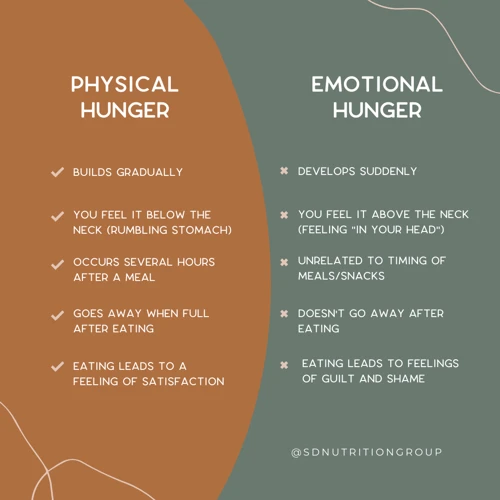
Navigating the complex relationship between food and emotions is not always easy. Emotional eating, or consuming food as a response to negative feelings rather than physical hunger signals, can be a difficult habit to break. Emotional hunger can often stem from a variety of triggers such as stress or anxiety, feelings of sadness or depression, or even mere boredom. This type of eating may also lead to guilt or shame, perpetuating a negative cycle of unhealthy behaviors. Understanding the signs and effects of emotional hunger can help you develop techniques and strategies to manage it effectively.
Common Triggers of Emotional Hunger
Emotional hunger is often triggered by certain psychological factors and situations. These triggers can vary from person to person, and it is essential to recognize them to gain control over emotional eating habits. Below are some common triggers of emotional hunger, categorized as external and internal factors:
| External Triggers | Internal Triggers |
|---|---|
|
|
Identifying these triggers can help you develop strategies to manage emotional eating. For example, if stress is a trigger for you, you may need to find alternative ways to manage stress, like exercise or meditation. If food cravings are a trigger, you may need to find healthier substitutions or find ways to distract yourself when cravings strike.
Learning to manage emotional hunger can be challenging, but it is a crucial step in developing a healthy relationship with food. For more information on mindful eating techniques, how to improve self-esteem and control emotional eating for weight loss, and how to build and maintain a healthy relationship with food, explore our other articles.
Effects of Emotional Eating
Emotional eating can have several negative effects on an individual’s physical and mental well-being. Some of these effects include:
- Weight Gain: Emotional eating often leads to consuming food high in sugar or fat, thus leading to weight gain and obesity.
- Disordered Eating: Emotional eating can contribute to disordered eating patterns, such as binge eating disorder or bulimia.
- Increased Stress Levels: Emotional eating can lead to increased levels of stress and anxiety, as overeating can cause guilt and shame.
- Poor Nutrition: Eating to cope with emotions often involves consuming processed or junk food, leading to inadequate nutrition and deficiencies in essential vitamins and minerals.
- Decreased Mental Health: Emotional eating can contribute to feelings of low self-esteem, anxiety, and depression, as an individual may use food to cope with negative emotions instead of addressing underlying issues.
It is important to recognize the impact emotional eating can have on an individual’s health and well-being, and to seek support in developing healthier coping mechanisms.
How to Identify Physical Hunger
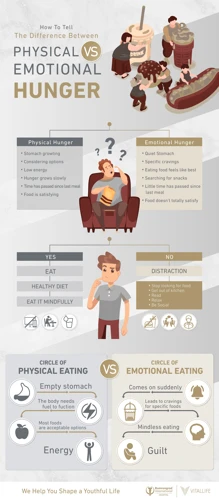
One of the key components of distinguishing physical hunger from emotional hunger is being able to recognize the signs of physical hunger. It may seem simple, but sometimes it can be difficult to differentiate between actual hunger and other feelings that can make us believe we need to eat. However, by paying attention to specific signals our body sends when it needs nourishment, we can become better at identifying physical hunger and making informed decisions about what and when to eat. Let’s take a closer look at some of these signals.
Gradual Onset
One key way to distinguish physical hunger from emotional hunger is to pay attention to the onset of the hunger. Physical hunger tends to come on gradually over time, whereas emotional hunger can come on suddenly and intensely.
Here are some potential signs of gradual onset physical hunger to be aware of:
- Feeling low energy: If you haven’t eaten for several hours and are starting to feel lethargic or run down, this could be a sign that your body needs nourishment.
- Increased stomach growling: When your stomach is empty, it can start to make noise as it digests the remaining contents.
- Feeling “empty” or “hollow”: A feeling of emptiness or hollowness in your stomach is often a sign of physical hunger.
- Difficulty focusing: If you’re having trouble concentrating or staying on task, physical hunger may be affecting your mental clarity.
Pay attention to these signs and give yourself time to notice whether they worsen or improve over time before rushing to eat. If you’re experiencing gradual onset physical hunger, you may want to consider having a healthy snack or meal to nourish your body and maintain consistent energy levels throughout the day.
Stomach Growling
One of the most common indicators of physical hunger is the sound of the stomach growling. When the stomach is empty, it releases digestive fluids that make a rumbling sound, signaling that it’s time to eat. This physical symptom of hunger can often be accompanied by a feeling of emptiness or hollowness in the stomach.
It’s important to note that stomach growling can also occur when we’re not necessarily hungry, such as when we’re anxious or nervous. In these instances, the sound is not always an accurate indicator of true physical hunger. However, if the stomach growling is paired with other signs of physical hunger, such as weakness or irritability, it’s likely that your body is genuinely craving sustenance.
How to Identify Stomach Growling as a Sign of Physical Hunger
Here are some tips for distinguishing stomach growling as a symptom of physical hunger:
| Physical Hunger | Not Physical Hunger |
| Accompanied by feelings of emptiness or hollowness in the stomach | Occurs during times of anxiety or nervousness |
| Paired with other symptoms of hunger, such as irritability or weakness | Not accompanied by other physical symptoms of hunger |
| Gradual onset | Sudden onset |
If you’re experiencing stomach growling and are uncertain if it’s a sign of true physical hunger, take a moment to check in with yourself and assess if you’re experiencing any other physical symptoms such as weakness or tiredness. If you are, it may be a sign that it’s time to fuel your body with nutritious food.
Physical Symptoms
When it comes to identifying physical hunger, paying attention to physical symptoms is crucial. Here are some common physical symptoms that may indicate physical hunger:
| Physical Symptoms | Description |
|---|---|
| Increase in stomach growling | One of the most common signs of physical hunger is an increase in stomach growling. This growling noise is caused by the movement of food and digestive juices through the digestive tract. |
| Weakness or lightheadedness | If you are physically hungry, you may feel weak or lightheaded. This is because the body is not receiving the energy it needs from food. |
| Headache | When you are low on glucose, you may experience a headache. |
| Irritability or difficulty concentrating | Low blood sugar levels can cause feelings of irritability or difficulty concentrating. |
| Stomach discomfort or pain | Physical hunger can cause stomach discomfort or pain. This sensation is often described as a gnawing feeling or an emptiness in the stomach. |
It’s important to note that these symptoms should not be confused with symptoms of overeating, which can also cause stomach discomfort, headache, and difficulty concentrating. By paying attention to these physical symptoms, you can better identify when your body is truly hungry and needs nourishment.
Mental Clarity
One of the ways to identify physical hunger is by noticing your mental clarity. When you are physically hungry, you will experience a sense of mental alertness and focus. This is because when you are hungry, your body is releasing hormones that signal your brain to increase its activity level.
You may find that when you are hungry, you are better able to concentrate on tasks or solve problems. This can be particularly noticeable if you have been working or studying for an extended period of time and start to feel your energy levels waning. Once you eat something, you may experience a renewed ability to focus and think clearly.
Here are some indicators that can help you determine if you are experiencing mental clarity:
- You are able to maintain focus on a task or assignment for an extended period of time.
- You feel more alert and awake than usual.
- Your thoughts are more organized and clear.
- You are able to multitask and switch between tasks with ease.
- You feel motivated and energized to complete tasks.
- You are able to think creatively and generate new ideas.
Mental clarity is a subtle but important indicator of physical hunger. Paying attention to your cognitive abilities can help you differentiate between physical and emotional hunger, and make better food choices that will support your overall health and wellbeing.
How to Identify Emotional Hunger
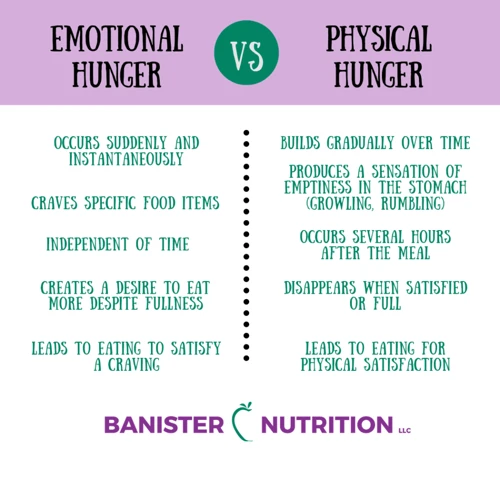
It can be challenging to distinguish between physical hunger and emotional hunger. Unlike physical hunger, emotional hunger is driven by feelings rather than by the need to nourish your body. Emotional hunger can strike suddenly and cause cravings for specific foods that may not even be nutritious. Fortunately, by understanding the signs of emotional hunger, you can learn to identify it and deal with it in a healthy way. Let’s dive into some key ways to identify emotional hunger.
Sudden Onset
When it comes to emotional hunger, one common characteristic is its sudden onset. Unlike physical hunger, which gradually builds up over time, emotional hunger can hit you unexpectedly and urgently. You may find yourself suddenly feeling like you need to eat something specific or eat right away, even if you recently ate.
Here are some signs of sudden onset emotional hunger:
- Feeling like you need to eat something specific, such as chocolate or chips
- Experiencing a sudden urge to snack or indulge
- Feeling like you’re “starving” even though you’re not actually hungry
- Feeling like you need to eat right away
It’s important to note that emotional hunger can be triggered by a variety of factors, including stress, boredom, and even positive emotions like excitement. Recognizing the sudden onset of emotional hunger can help you pause and assess whether you’re physically hungry or if there is an emotional trigger behind your desire to eat. By acknowledging and addressing the emotional trigger, you can learn to develop better coping mechanisms and habits for managing your emotional hunger.
Craving Specific Foods
One of the signs of emotional hunger is craving specific foods. When we experience emotional hunger, we tend to crave certain types of foods that provide us with a sense of comfort or pleasure. These foods are often high in sugar, fat, or salt, and can be a way of coping with negative emotions or stress.
Some common examples of specific food cravings include chocolate, ice cream, pizza, or other comfort foods. These cravings can be triggered by a stressful event, a negative emotion such as anxiety or sadness, or even just boredom.
It’s important to recognize that these food cravings are often not driven by physical hunger, but rather by emotional needs. Giving in to these cravings can provide temporary relief, but can ultimately lead to negative emotional and physical effects such as guilt, shame, and weight gain.
To combat these cravings, it’s important to identify and address the underlying emotional triggers. An effective way to do this is to keep a food journal and document the emotions and circumstances surrounding each craving. This can help to identify patterns and triggers, and allow for the development of healthier coping mechanisms.
Finding healthier substitutes for these specific food cravings can be helpful. For example, if you tend to crave sugary snacks when stressed, try replacing them with fresh fruit or a small handful of nuts.
Recognizing and addressing emotional hunger and specific food cravings can be challenging, but taking the time to do so can lead to healthier and happier habits in the long run.
Eating Beyond Fullness
One of the key signs of emotional hunger is eating beyond fullness. When we eat emotionally, we tend to eat until we are uncomfortably full, often with foods that are high in fat, sugar, and/or salt. This is because we are seeking comfort and satisfaction from the act of eating, rather than simply fueling our bodies.
Unfortunately, eating beyond fullness can be harmful to our overall health, leading to weight gain, digestive issues, and an increased risk of chronic disease. It can also perpetuate the cycle of emotional eating, as we may feel guilty or ashamed after overeating, leading us to turn to food again as a way to cope with those negative emotions.
To combat the tendency to eat beyond fullness, it can be helpful to practice mindful eating. This involves paying attention to our hunger and fullness cues, and eating slowly and consciously. One way to do this is to take smaller bites and chew our food thoroughly, which can help us feel more satisfied with less food. Another tip is to pause between bites and check in with our body, asking ourselves if we are still hungry or if we are starting to feel full.
It can also be helpful to plan our meals and snacks in advance, so we have a clear idea of what and how much we will be eating. This can help us avoid mindless snacking and overeating, especially if we make sure to include a balance of protein, fiber, and healthy fats in our meals. Similarly, maintaining consistency in our eating habits, such as eating at regular times throughout the day, can also help us avoid the urge to overeat.
All in all, practicing mindful eating, planning our meals and snacks, and maintaining consistency can help us avoid eating beyond fullness and keep emotional eating in check. By being mindful of our hunger and fullness cues, we can learn to listen to our bodies and give ourselves the nourishment we need – without relying on food as our sole source of comfort.
Emotional Triggers
Emotional hunger is often triggered by emotions such as stress, anxiety, sadness, loneliness, boredom, and even happiness. These emotional triggers affect our eating behaviors and can drive us to seek comfort in food as a coping mechanism. It is important to understand these triggers and find healthier ways to cope with emotions.
| Emotional Triggers | Impact on Eating Behaviors |
|---|---|
| Stress | Stress can lead to increased cortisol levels in the body, which can stimulate appetite and cravings for high-fat, high-sugar foods. |
| Anxiety | Anxiety can cause a sense of unease in the stomach which can drive the urge to eat. Some people may also use food as a distraction from their anxious thoughts. |
| Sadness | Sadness can cause feelings of loneliness and isolation which can lead to emotional eating as a way to find comfort and feel better. |
| Loneliness | Loneliness can also lead to emotional eating as a way to cope with feelings of isolation and disconnection from others. |
| Boredom | Boredom can drive us to eat out of a desire for stimulation and entertainment, rather than actual hunger. |
| Happiness | Even positive emotions like happiness can trigger emotional eating, as we may associate certain foods with celebrations and reward. |
By identifying these emotional triggers, we can start to develop healthier coping strategies and break the cycle of emotional eating. It may be helpful to journal our emotions and food cravings to identify patterns and find alternative ways to handle our emotions. Seeking support from a therapist or a support group can also be beneficial in learning to manage emotional triggers and develop healthier habits.
Coping Strategies for Emotional Hunger
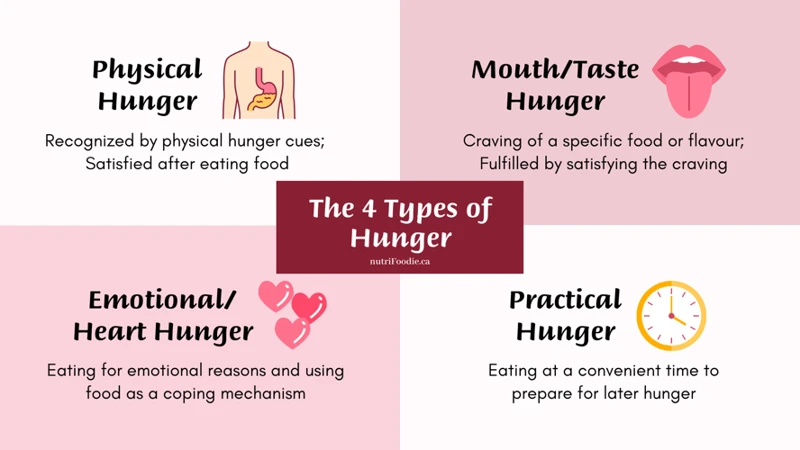
Dealing with emotional hunger can be a challenging task. It involves overcoming intense feelings and recognizing the root causes of emotional eating. Fortunately, there are effective coping strategies to combat emotional hunger that can help redirect your focus towards more nutritious and fulfilling eating habits. By implementing the following strategies to cope with emotional eating, you can regain control of your eating habits, reduce triggers, and improve your overall well-being.
Identifying Triggers and Substitutes
One effective strategy for coping with emotional hunger is identifying triggers and finding substitutes. This involves recognizing the emotions or situations that trigger a desire to emotionally eat, and developing healthier ways to deal with those triggers. Here are some steps to take:
- Keep a food journal: Write down when and what you eat, as well as how you’re feeling at the time. This can help you identify patterns that may indicate emotional eating.
- Identify triggers: Look for patterns in your food journal, noting what types of situations or emotions are associated with emotional eating. Some common triggers include stress, boredom, loneliness, and sadness.
- Find substitutes: Once you’ve identified your triggers, brainstorm alternative activities that can help you cope with them. For example, if stress is a trigger, try taking a walk or doing some deep breathing exercises instead of reaching for food.
- Be patient: Changing habits takes time and practice. Don’t be discouraged if you slip up and emotionally eat. Use it as an opportunity to learn more about your triggers and find even better substitutes.
By identifying triggers and finding substitutes, you can develop healthier coping mechanisms for dealing with difficult emotions. This can help you break the cycle of emotional eating and improve your overall well-being.
Finding Other Ways to Cope with Emotions
One effective way to manage emotional hunger is by finding alternative ways to cope with one’s emotions. Emotional eating typically occurs when an individual experiences negative emotions, such as stress or anxiety, and uses food as a means of comfort. Rather than relying on food to manage emotions, there are several other strategies that one can implement. Below are some examples:
| Strategy | Description |
|---|---|
| Journaling | Writing about one’s thoughts and emotions can help process and cope with them. This can be done in a physical journal or through a digital platform. |
| Meditation | Practicing mindfulness and meditation can help calm the mind and reduce stress. Various apps and guided meditations are available for beginners. |
| Exercise | Moving the body and engaging in physical activity can release endorphins, which can boost mood and reduce stress. |
| Listening to Music | Music can elevate mood and help distract from negative emotions. Creating a playlist of favorite songs can be a helpful tool. |
| Calling a Friend or Family Member | Receiving support from loved ones can be a source of comfort during difficult times. This can also strengthen relationships. |
It is important to note that different strategies may work for different individuals. It may be helpful to experiment and find what works best for oneself. By practicing alternative ways to cope with emotions, individuals can reduce the likelihood of relying on food as a source of comfort.
Mindful Eating and Self-Compassion
Mindful eating and self-compassion are essential in managing emotional hunger. Mindful eating involves paying attention to the entire experience of eating, including the taste, texture, and aroma of the food, as well as the feeling of fullness and satisfaction. This helps us tune in to our body’s signals and can help distinguish between physical and emotional hunger. Some tips for practicing mindful eating include:
- Eat slowly: Take the time to savor each bite and appreciate the flavors.
- Check in with your hunger and fullness cues: Pause periodically during a meal to assess how hungry or full you feel.
- Avoid distractions: Try to eat without any technological distractions and focus your attention solely on your food.
- Practice gratitude: Take a moment to express gratitude for the food you are about to consume and the nourishment it will provide.
Self-compassion involves being kind and gentle towards ourselves when we experience difficult emotions. Rather than beating ourselves up for emotional eating, self-compassion allows us to acknowledge our struggles with a sense of understanding and kindness. Some tips for practicing self-compassion include:
- Use positive self-talk: Reframe negative self-talk into positive affirmations, such as “I am doing the best I can” or “It’s okay to feel overwhelmed.”
- Practice self-care: Engage in activities that bring you joy and relaxation, whether it be taking a bubble bath or going for a nature walk.
- Acknowledge your emotions: Rather than suppressing or ignoring difficult emotions, try to acknowledge them and validate your own feelings.
- Seek support: Reach out to friends, family, or a professional for additional support in managing difficult emotions and experiences.
Incorporating these practices into our daily lives can help foster a healthier relationship with food and our emotions. By practicing mindfulness and self-compassion, we can learn to distinguish between physical and emotional hunger and develop coping strategies that meet our emotional needs in more productive ways.
Tips to Manage Cravings
Cravings can be powerful and difficult to resist. They can also be a trigger for emotional eating, which can lead to unhealthy food choices and negative effects on our physical and mental well-being. However, with the right strategies in place, managing cravings can become less daunting. In this section, we’ll explore some helpful tips and techniques to help you manage your cravings and make healthier choices. Let’s dive in!
Planning Meals and Snacks
One effective strategy for managing cravings and distinguishing physical hunger from emotional hunger is to plan meals and snacks in advance. By doing so, you can ensure that you are regularly consuming healthy foods that provide the nutrients and energy your body needs throughout the day.
One way to approach meal planning is to create a weekly menu that includes a variety of nutrient-dense foods, such as fruits, vegetables, whole grains, lean proteins, and healthy fats. This can help you avoid the temptation to reach for unhealthy snack foods when hunger strikes.
To make meal and snack planning easier, consider creating a table that outlines your options for various times of day. For example:
| Breakfast | Snack Options | Lunch | Snack Options | Dinner | Snack Options |
|---|---|---|---|---|---|
| Whole grain toast with avocado and egg | Apple slices with almond butter | Grilled chicken salad with mixed greens, vegetables, and vinaigrette | Carrot sticks with hummus | Baked salmon with roasted veggies and brown rice | Plain Greek yogurt with berries and honey |
| Oatmeal with nuts and fruit | Homemade trail mix with nuts and dried fruits | Turkey and cheese wrap with raw veggies and mustard | Pear slices with cheddar cheese | Vegetarian chili with whole grain crackers | Cottage cheese with grapes and walnuts |
| Banana and peanut butter smoothie | Roasted chickpeas | Quinoa salad with mixed veggies and feta cheese | Sliced bell peppers and hummus | Grilled steak with baked sweet potato and roasted asparagus | Dark chocolate and almonds |
This way, you have a list of healthy options readily available when hunger strikes and you can quickly put together a satisfying meal or snack without much thought. Plus, having a plan can help you resist the urge to reach for unhealthy convenience foods or give in to emotional eating triggers.
Remember to also listen to your body and adjust your meal plan as needed. If you find that you are consistently hungry between meals, consider adding more protein or fiber-rich foods to help keep you feeling full longer. With a little bit of planning and creativity, you can create a meal plan that both nourishes your body and satisfies your taste buds.
Eating Balanced Meals
When it comes to managing cravings and distinguishing physical hunger from emotional hunger, eating balanced meals is crucial. A balanced meal should contain a combination of protein, complex carbohydrates, and healthy fats. Here are some tips to help you create balanced meals:
- Incorporate lean sources of protein such as chicken, fish, tofu, or beans into your meals.
- Choose complex carbohydrates such as whole grains, sweet potatoes, or quinoa, instead of simple carbohydrates like white bread and sugary foods.
- Include healthy fats such as avocado, nuts, seeds, or olive oil in your meals.
- Try to have a variety of colors on your plate by including different fruits and vegetables.
- Make sure to drink plenty of water throughout the day and with your meals.
Consuming balanced meals can help you feel more satisfied and reduce cravings for unhealthy foods. By providing your body with the nutrients it needs, you may be less likely to turn to emotional eating to fill any nutritional gaps. Additionally, eating balanced meals can help regulate blood sugar levels and prevent energy crashes, which can also contribute to emotional cravings.
Maintaining Consistency
Maintaining Consistency is an important factor when it comes to managing cravings and differentiating physical hunger from emotional hunger. It essentially involves making sustainable lifestyle changes and sticking to them in the long run. Consistency means making healthy choices every day, despite one’s mood or circumstance. It’s about building a routine that works for you and your body. Here are some tips for maintaining consistency:
| 1. Create a Meal Plan: | Plan your meals ahead of time to ensure that you’re eating balanced, nutritious meals throughout the day. Stick to your plan as much as possible. |
| 2. Keep Healthy Snacks on Hand: | Having healthy snacks readily available can help prevent you from reaching for junk food when hunger strikes. Keep snacks like fresh fruits, veggies, or nuts easily accessible. |
| 3. Practice Portion Control: | Learn to control your portions and avoid overeating during meals. Using smaller plates, measuring food, or eating slowly can help you eat less without feeling deprived. |
| 4. Build a Support System: | Having supportive friends or family members can help you stay motivated and accountable. Joining a fitness group or finding a workout buddy can also be helpful. |
| 5. Track Your Progress: | Keeping a food and exercise journal can help you see your progress and identify areas that need improvement. Celebrate small victories and don’t beat yourself up over setbacks. |
By maintaining consistency and making healthy choices a habit, you can establish a healthy relationship with food and your body. Remember to be patient and kind to yourself as you make these changes, and always prioritize your physical and emotional well-being.
Practice Mindful Eating
One effective way to manage cravings and distinguish between physical and emotional hunger is practicing mindful eating. Mindful eating involves paying close attention to the experience of eating, which can help prevent overeating and emotional eating.
Here are some tips for incorporating mindful eating into your routine:
| Tips for Practicing Mindful Eating |
|---|
| Take your time. Eating slowly and savoring each bite allows you to tune into your body’s hunger and fullness signals, which can help prevent overeating. |
| Engage your senses. Take notice of the colors, textures, and flavors of your food. This can help you appreciate the experience of eating and avoid distractions that may lead to mindless snacking. |
| Focus on the present moment. Try to eat without distractions, such as television or your phone. This can help you tune into your body’s hunger signals and prevent emotional eating. |
| Listen to your body. Pay attention to how your body feels before, during, and after eating. This can help you identify physical hunger and prevent emotional eating. |
| Practice self-compassion. Be kind to yourself and avoid harsh self-criticism if you overeat or eat emotionally. Recognize that developing a healthy relationship with food takes time and practice. |
By practicing mindful eating, you can develop a more intuitive relationship with food and learn to distinguish between physical and emotional hunger. This can help you develop healthier eating habits and achieve your health and wellness goals.
Conclusion
In conclusion, distinguishing physical hunger from emotional hunger can be challenging, but it is an essential step towards maintaining a healthy relationship with food. Physical hunger is the body’s natural way of indicating that it needs fuel, and ignoring it can be detrimental to one’s health. On the other hand, emotional hunger arises from psychological triggers, such as stress or boredom, and gives rise to cravings for certain foods.
To identify physical hunger, one should look for signs such as a gradual onset, stomach growling, physical symptoms like headache, and mental clarity. On the other hand, emotional hunger has a sudden onset, results in specific cravings for comfort foods, eating beyond fullness, and is often tied to emotional triggers.
Coping with emotional hunger requires identifying triggers and substituting comfort foods with healthier options. Finding alternate ways to cope with emotions, like journaling, exercising, or practicing mindfulness, can help shift the focus away from food. Practicing mindful eating and self-compassion can also be helpful in managing emotional eating.
Finally, managing cravings requires planning meals and snacks, eating balanced meals, maintaining consistency, and practicing mindful eating. By taking these steps, one can build a healthy relationship with food and enjoy a well-rounded, nutritious diet. Remember, food is not just about satisfying hunger; it is also a source of pleasure and enjoyment, and a vital component of overall health and wellness.
Frequently Asked Questions
What is the difference between physical and emotional hunger?
Physical hunger is the biological need for nourishment, while emotional hunger is triggered by an emotional state.
What are the signs of physical hunger?
The signs of physical hunger include gradual onset, stomach growling, physical symptoms, and mental clarity.
What happens if you ignore physical hunger?
If you ignore physical hunger, you may experience low energy, irritability, and difficulty concentrating.
What are common triggers of emotional hunger?
Common triggers of emotional hunger include stress, boredom, anxiety, and loneliness.
What happens when you engage in emotional eating?
Emotional eating can lead to overeating, weight gain, and negative emotions such as guilt and shame.
What are some physical symptoms of hunger?
Physical symptoms of hunger include headache, dizziness, and fatigue.
What are some strategies for coping with emotional hunger?
Strategies for coping with emotional hunger include identifying triggers and substitutes, finding other ways to cope with emotions, and practicing mindful eating and self-compassion.
How can you manage cravings?
You can manage cravings by planning meals and snacks, eating balanced meals, maintaining consistency, and practicing mindful eating.
What is mindful eating?
Mindful eating involves paying attention to the taste, texture, and smell of food while eating, as well as listening to the body’s hunger and fullness cues.
Why is it important to distinguish between physical and emotional hunger?
It is important to distinguish between physical and emotional hunger because it can help you make healthier food choices, manage weight, and improve overall well-being.

